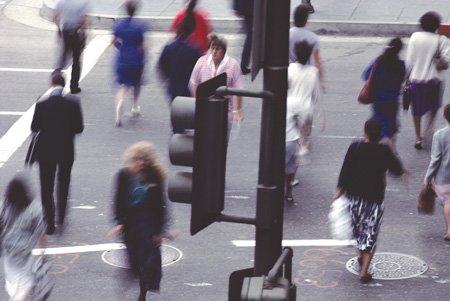 |
COMMISSIONER'S LETTER |
By New York City Taxi and Limousine Commission
Chairwoman & Cheif Executive Officer
Meera Joshi
Greetings, all! I hope you are enjoying the beautiful autumn and are gearing up for many warm, safe trips this winter.
Daylight Saving Time and Street Safety
Signaling the change of seasons, the end of Daylight Saving Time is almost upon us. Early Sunday, November 6, it will be time to move our clocks back one hour, giving us more light in the morning, and balancing the scales with an earlier sunset and evenings that get darker more quickly. It is important during this time to be vigilant about the potential for collisions when it is harder to see.
During dusk, more pedestrians are hurt in crashes than at any other time, and our vision drops tenfold as night falls. The lack of light makes it difficult for eyes to focus properly - depth perception, peripheral vision, and color vision all suffer. A driver might not recognize pedestrians until it is too late. Pedestrians, particularly children, may also not realize at 5 p.m. how dark it is outside, and how little visibility there might be. So please, during dusk and evening, be extra aware and cautious.
Pedestrian fatalities typically go up by 50% from September through January in New York City. Each year, traffic crashes cause more than 200 deaths a year citywide, as well as about 4,000 serious injuries. We need your help in making this pattern a distant memory.
When you are on the road you can make a major contribution to making our streets safer by turning slowly, always looking for pedestrians, and carefully pausing to scan all crosswalks before making a turn. Even though the one hour time difference may not seem significant, it is important not to underestimate it and give yourself extra time to rest as your body adjusts.
Fatigue can decrease reaction time and coordination, and puts you at greater risk of a crash. We appreciate TLC-licensed driversí efforts to stay rested and alert as well as to continue the courteous, safe service that they provide to so many each day.

Driver Fatigue
Speaking of the importance of rest is also a good opportunity to update you all on the Driver Fatigue Prevention rules that were approved by the TLC on July 18. These rules will not go into effect on November 1, 2016. The TLC continues to finalize the methodology for calculating work hours. Accordingly, the implementation of these rules is delayed until further notice.
No warnings or summonses for these rules will be issued to drivers or bases while the methodology is finalized.
Over the next few months, TLC will communicate any updates to the rules, including when enforcement would begin.
Accessible Dispatch
Our Accessible Dispatch program, where passengers using a wheelchair can book a taxi through phone, text, and online, continues to serve more and more people each month. In September, there were almost 6,000 completed trips, the program's highest month ever since it began in 2012.
There were are also more than 45,000 rides through the end of September this year. We recently published rules on the expansion of the program to make it citywide at www.nyc.gov/taxi, and look forward to hearing your thoughts on the rules during a hearing on Nov. 10 at 33 Beaver Street, 19th floor.
Lost Property Unit
I'd like to take a moment to crow about a team of TLC miracle workers who are dedicated to helping reunite passengers with the 100 items per-day, on average, left behind in cabs. Whether it is a rider's lost wedding ring, puppy in a carrier, passport, medicine, or a musical instrument, the TLC doggedly searches for missing property. I would put the detective skills of call center representative Gloria Ramos ("I don't stop until I find something!") up against Columbo any day! I am grateful for the dedication of all our staff working to recover lost property for the riding public.
To give you an example of the hard work they put in, staffer Sarah Phillips finds missing property at least 20 times each day for riders. Some of her finds include a wedding band, two guitars, and forgotten medicine. The most memorable moment for staff member Jose Morrobel is when he finds something of sentimental value, such as a pair of reading glasses that a grandmother who passed away had given the rider.
The TLC is always gratified when a lost item is found, but my favorite part of these success stories is when I hear about those drivers who've gone WAY above and beyond the call of duty to serve their forgetful passengers. For instance, there is the taxi driver who recently returned passports to a family that had left them in a handbag in his cab before they had even noticed they were gone. That driver is just one of countless licensees who give exceptional service and make New York City a fantastic place to visit and live.
Winterize Your Vehicle
As the years go by, it seems we are experiencing less and less transition between seasons. So, despite the fact that this column is being written on an 80-degree day in late October, the time is now to get your car ready for that first patch of black ice, and that first snowfall. More to the point, it's crucial to both your safety and that of everyone around you that your car is in tip-top shape as temperatures drop.
First and foremost, make sure your tires have the appropriate groove depth to dig in when it's necessary. Nice deep grooves - 1/3" is optimal - will also prevent your vehicle from hydroplaning when those dreary late fall rains come. If you're not sure about your tread
depth, try the penny test - push a penny into the tread with Lincoln's head upside down. If his head isn't mostly covered by the tread, time to get those tires checked or replaced.
New wipers are another must, as is a full windshield washer fluid reservoir, and use a good quality windshield washer fluid that has anti-icing ingredients. Remember, the faster you clear your windshield after a slush-splash, the faster you'll be in full control!
Colder temps are just around the corner as well, so you may want to switch to a thinner oil for when the mercury goes below freezing. Flush-and-fill your radiator with a quality anti-freeze coolant that will protect your engine.
Don't forget to inspect your battery cable, hoses and belts for any cracks, leaks or fraying. Replacing them now will save you from a world of trouble if you break down in nasty weather!
Another good precaution, if you haven't already taken it, is to consider putting together an automotive "go bag" that includes a strong flashlight, extra coolant, engine oil, washer fluid, and flares or an electronic blinker in case you're stuck on the road or roadside. There are also some very good emergency battery packs on the market for a quick boost without having to wait for someone to stop.
Last, but most certainly not least - cold weather driving is all about caution. Black ice is a great example of the invisible hazards that we face in colder weather, but good preparation goes a long way and it will help you go a long way, too!
